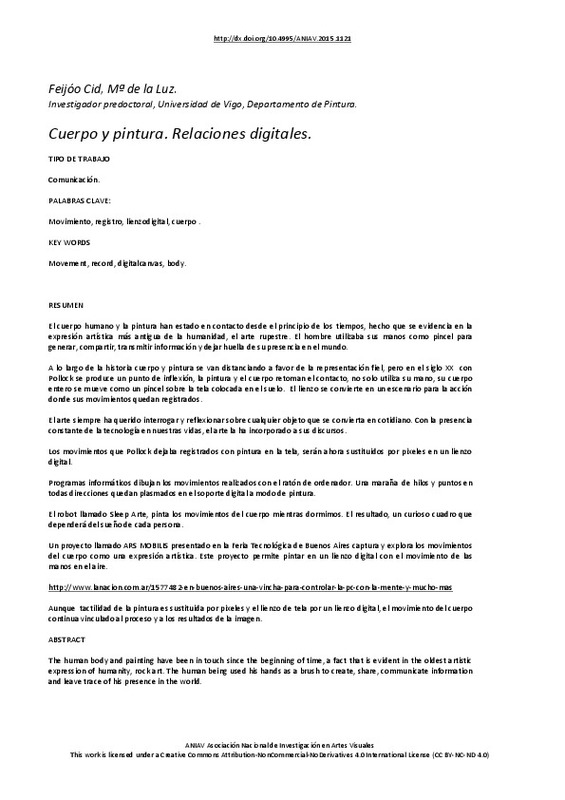JavaScript is disabled for your browser. Some features of this site may not work without it.
Buscar en RiuNet
Listar
Mi cuenta
Estadísticas
Ayuda RiuNet
Admin. UPV
CUERPO Y PINTURA. RELACIONES DIGITALES
Mostrar el registro sencillo del ítem
Ficheros en el ítem
| dc.contributor.author | FEIJOO CID, MARIA
|
es_ES |
| dc.date.accessioned | 2017-10-03T09:53:37Z | |
| dc.date.available | 2017-10-03T09:53:37Z | |
| dc.date.issued | 2015-11-26 | |
| dc.identifier.isbn | 9788490483411 | |
| dc.identifier.uri | http://hdl.handle.net/10251/88529 | |
| dc.description.abstract | [EN] The human body and painting have been in touch since the beginning of time, a fact that is evident in the oldest artistic expression of humanity, rock art. The human being used his hands as a brush to create, share, communicate information and leave trace of his presence in the world. Throughout history Body and Paint are moving away in favor of fair representation, but in the twentieth century with Pollock a turning point takes place, paint and body contact again, not only does he use his hand, his body whole moves as a brush onto the fabric placed on the ground. The canvas becomes a stage for action where his movements are recorded. Art has always wanted to question and reflect on anything that will become commonplace. With the constant presence of technology in our lives, art has incorporated into his speeches. The movements which Pollock left registered with paint on canvas, will now be replaced by pixels in a digital canvas. Software plotted the movements made with the computer mouse. A tangle of wires and dots are reflected in all directions in the digital format as paint. The robot called Sleep Art paints body movements during sleep. The result is a curious picture depending on everyone’s dreams. A project called ARS MOBILIS presented at the Feria Tecnológica de Buenos Aires captures and explores the body movements as an artistic expression. This project allows digital paint on a canvas with the movement of hands in the air. http://www.lanacion.com.ar/1577482Gen-buenos-aires-una-vincha-para-controlar-la-pc-con-la-mente-y-mucho-mas Althou-h tactile paintin- is replaced by pixels and canvas fabric by di-ital canvas, body movement continues to be linked to the process and to the results of the ima-e. | es_ES |
| dc.description.abstract | [ES] El cuerpo humano y la pintura han estado en contacto desde el principio de los tiempos, hecho que se evidencia en la expresión artística más antigua de la humanidad, el arte rupestre. El hombre utilizaba sus manos como pincel para generar, compartir, transmitir información y dejar huella de su presencia en el mundo. A lo largo de la historia cuerpo y pintura se van distanciando a favor de la representación fiel, pero en el siglo XX con Pollock se produce un punto de inflexión, la pintura y el cuerpo retoman el contacto, no solo utiliza su mano, su cuerpo entero se mueve como un pincel sobre la tela colocada en el suelo. El lienzo se convierte en un escenario para la acción donde sus movimientos quedan registrados. El arte siempre ha querido interrogar y reflexionar sobre cualquier objeto que se convierta en cotidiano. Con la presencia constante de la tecnología en nuestras vidas, el arte la ha incorporado a sus discursos. Los movimientos que Pollock dejaba registrados con pintura en la tela, serán ahora sustituidos por pixeles en un lienzo digital. Programas informáticos dibujan los movimientos realizados con el ratón de ordenador. Una maraña de hilos y puntos en todas direcciones quedan plasmados en el soporte digital a modo de pintura. El robot llamado Sleep Arte, pinta los movimientos del cuerpo mientras dormimos. El resultado, un curioso cuadro que dependerá del sueño de cada persona. Un proyecto llamado ARS MOBILIS presentado en la Feria Tecnológica de Buenos Aires captura y explora los movimientos del cuerpo como una expresión artística. Este proyecto permite pintar en un lienzo digital con el movimiento de las manos en el aire. http://www.lanacion.com.ar/1577482-en-buenos-aires-una-vincha-para-controlar-la-pc-con-la-mente-y-mucho-mas Aunque tactilidad de la pintura es sustituida por pixeles y el lienzo de tela por un lienzo digital, el movimiento del cuerpo continua vinculado al proceso y a los resultados de la imagen. | es_ES |
| dc.format.extent | 7 | es_ES |
| dc.language | Español | es_ES |
| dc.publisher | Editorial Universitat Politècnica de València | es_ES |
| dc.relation.ispartof | II CONGRESO INTERNACIONAL DE INVESTIGACIÓN EN ARTE VISUALES | es_ES |
| dc.rights | Reconocimiento - No comercial - Sin obra derivada (by-nc-nd) | es_ES |
| dc.subject | Arte | es_ES |
| dc.subject | Producción artística | es_ES |
| dc.subject | Estética | es_ES |
| dc.subject | Teoría del Arte | es_ES |
| dc.subject | Gestión cultural | es_ES |
| dc.subject | Educación artística | es_ES |
| dc.subject | Investigación artística | es_ES |
| dc.title | CUERPO Y PINTURA. RELACIONES DIGITALES | es_ES |
| dc.type | Capítulo de libro | es_ES |
| dc.type | Comunicación en congreso | es_ES |
| dc.identifier.doi | 10.4995/ANIAV2015.1121 | |
| dc.rights.accessRights | Abierto | es_ES |
| dc.description.bibliographicCitation | Feijoo Cid, M. (2015). CUERPO Y PINTURA. RELACIONES DIGITALES. En II CONGRESO INTERNACIONAL DE INVESTIGACIÓN EN ARTE VISUALES. Editorial Universitat Politècnica de València. 257-264. https://doi.org/10.4995/ANIAV2015.1121 | es_ES |
| dc.description.accrualMethod | OCS | es_ES |
| dc.relation.conferencename | II Congreso Internacional de Investigación en Artes Visuales. |< real | virtual >| ANIAV2015 | es_ES |
| dc.relation.conferencedate | July 09-10,2015 | es_ES |
| dc.relation.conferenceplace | Valencia, Spain | es_ES |
| dc.relation.publisherversion | http://ocs.editorial.upv.es/index.php/ANIAV/ANIAV2015/paper/view/1121 | es_ES |
| dc.description.upvformatpinicio | 257 | es_ES |
| dc.description.upvformatpfin | 264 | es_ES |
| dc.type.version | info:eu-repo/semantics/publishedVersion | es_ES |
| dc.relation.pasarela | OCS\1121 | es_ES |








